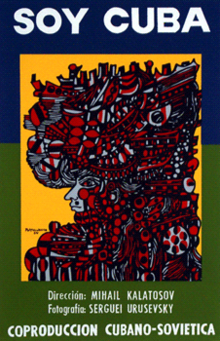Soy Cuba
| I Am Cuba | |
|---|---|
 |
|
| Directed by | Mikhail Kalatozov |
| Produced by |
Bela Fridman Semyon Maryakhin Miguel Mendoza |
| Written by | Enrique Pineda Barnet Yevgeny Yevtushenko |
| Starring |
Sergio Corrieri Salvador Wood José Gallardo Jean Bouise |
| Music by | Carlos Fariñas |
| Cinematography | Sergey Urusevsky |
| Edited by | Nina Glagoleva |
| Distributed by | Instituto Cubano del Arte e Industrias Cinematográficos (ICAIC) Milestone Films |
|
Release date
|
1964 8 March 1995 (US) 22 May 2003 (Cannes Film Festival) |
|
Running time
|
135 minutes / 141 minutes |
| Country |
Cuba Soviet Union |
| Language | Spanish English |
I Am Cuba (Spanish: Soy Cuba; Russian: Я Куба, Ya Kuba) is a 1964 Soviet-Cuban film directed by Mikhail Kalatozov at Mosfilm. The film was not received well by either the Russian or Cuban public and was almost completely forgotten until it was re-discovered by filmmakers in the United States thirty years later. The acrobatic tracking shots and idiosyncratic mise en scene prompted Hollywood directors like Martin Scorsese to begin a campaign to restore the film in the early 1990s.
The film is shot in black and white, sometimes using infrared film obtained from the Soviet military to exaggerate contrast (making trees and sugar cane almost white, and skies very dark but still obviously sunny). Most shots are in extreme wide-angle and the camera passes very close to its subjects, whilst still largely avoiding having those subjects ever look directly at the camera.
Shortly after the 1959 Cuban revolution overthrew the dictatorship of Fulgencio Batista, the socialist Castro government, isolated by the United States after the latter broke diplomatic and trade relations in 1961, turned to the USSR for film partnerships. The Soviet government, interested in promoting international socialism, agreed to finance a film about the Cuban revolution.
The director was given considerable freedom to complete the work, and was given much help from both the Soviet and Cuban governments. The film made use of innovative techniques, such as coating a watertight camera's lens with a special submarine periscope cleaner, so the camera could be submerged and lifted out of the water without any drops on the lens or film. At one point, more than 1,000 Cuban soldiers were moved to a remote location to shoot one scene—this despite the then-ongoing Cuban Missile Crisis.
...
Wikipedia
